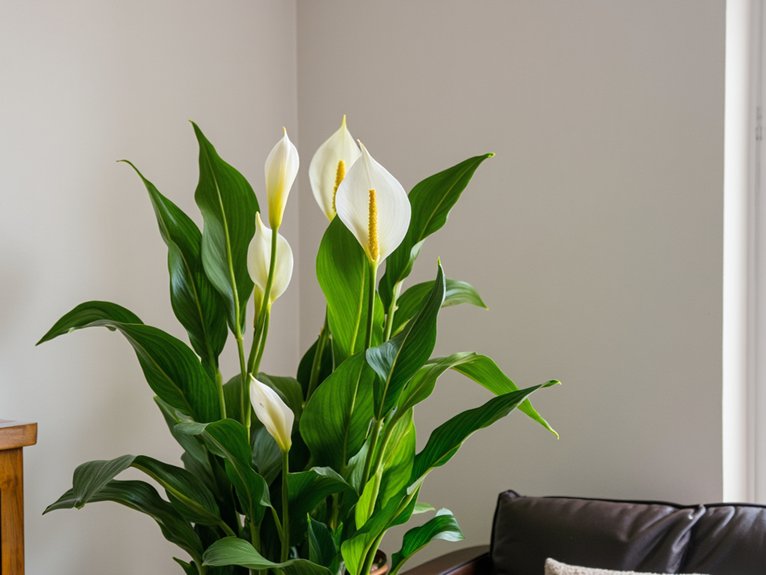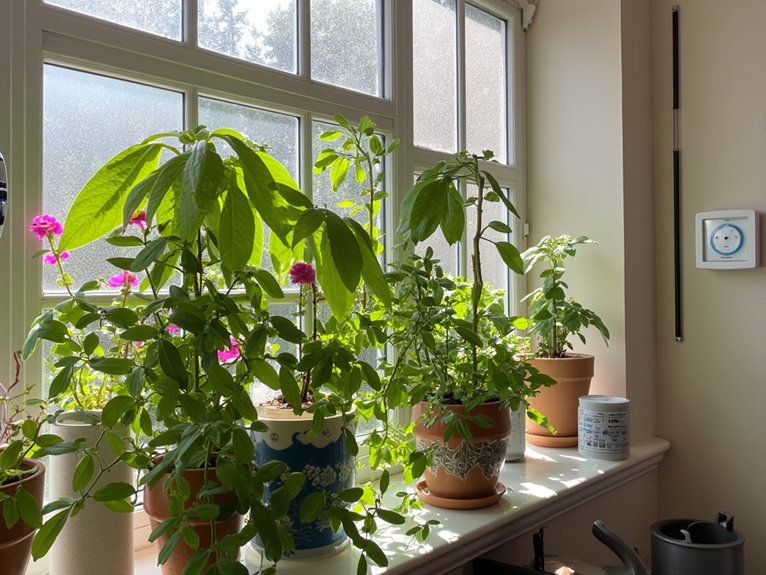You’ve probably noticed how flowering houseplants can transform a dull room into a vibrant sanctuary. “Indoor blooms serve as natural mood lifters while purifying your air,” says botanist Dr. Sarah Chen of Cornell University. With over 100 species that thrive indoors, you’ll find options for every light level and care routine. From classic peace lilies to exotic orchids, these botanical beauties offer year-round color – when you know the right growing secrets.
Contents
Why Indoor Flowering Plants Matter

While many people view indoor plants purely as decoration, flowering houseplants serve multiple essential purposes in your home environment. They’re natural air purifiers, removing common indoor pollutants while releasing fresh oxygen into your space. You’ll notice significant emotional benefits too – studies show that blooming plants can reduce stress levels and improve your mood through their vibrant colors and fragrances.
Beyond their aesthetic appeal, flowering plants create a living ecosystem in your home. They help maintain healthy humidity levels and can serve as natural aromatherapy. If you’re looking to enhance your indoor environment, consider adding these botanical powerhouses to your space.
Top Light-Loving Bloomers for Your Home
Having explored why flowering plants matter indoors, let’s focus on the sun-loving varieties that’ll thrive in your brightest spaces.
Several flowering plants demand bright light to produce vibrant blooms. The Hibiscus stands out, requiring direct sunlight for its trumpet-shaped flowers in red, orange, pink, and yellow. Geraniums also need bright, direct light to maintain their colorful display. For spaces with bright, indirect light, consider the Desert Rose, which needs at least 8 hours daily for ideal flowering. The Calamondin Orange thrives in similar conditions, rewarding you with fragrant white blossoms that develop into small citrus fruits.
Best Low-Maintenance Flowering Plants

When you’re seeking indoor flowering plants that don’t require constant care, several low-maintenance options can brighten your space. The Kalanchoe stands out with its vibrant colors and minimal water needs, blooming for weeks in shades of yellow, red, and orange.
For easy care success, consider these proven performers:
- Peace Lily – Thrives in indirect light and signals when it needs water
- African Violet – Compact at 6-12 inches with year-round blooms
- Christmas Cactus – Produces colorful winter flowers with basic care
These plants deliver reliable blooms while forgiving occasional lapses in maintenance.
Year-Round Color: Plants That Bloom in Every Season
To enjoy indoor blooms throughout all four seasons, you’ll need a thoughtful mix of flowering plants with different bloom cycles. Consider these year-round performers:
- African Violets and Peace Lilies bloom reliably with proper care
- Christmas Cactus delivers winter color while Kalanchoe brightens spring
- Hibiscus and Geraniums shine in summer months
- Cyclamen and Rieger Begonias flower during fall and winter
For the best seasonal blooms, rotate your indoor variety based on natural flowering periods. Keep plants near windows with appropriate light exposure, and maintain consistent watering schedules. Remember that each plant has specific needs for peak blooming.
Creating the Perfect Environment for Indoor Flowers

Success with indoor flowering plants starts with mastering their environmental needs for light, temperature, and humidity. Most flowering houseplants thrive in temperatures between 65-75°F during the day and slightly cooler at night.
For proper humidity control, group plants together or use humidity trays filled with pebbles and water. Your soil selection should focus on well-draining mixes specifically formulated for indoor plants.
Position plants near east or west-facing windows for bright, indirect light. Remember that seasonal changes affect light intensity – you’ll need to adjust plant locations accordingly. Monitor moisture levels by checking the top inch of soil before watering.
Essential Care Tips for Long-Lasting Blooms
Maintaining vibrant, long-lasting blooms requires consistent care and attention to your indoor plants’ specific flowering needs. To guarantee your plants thrive, monitor soil moisture levels carefully – most flowering plants need the top inch to feel slightly dry before watering again.
Master proper pruning techniques by removing spent blooms and yellowing leaves weekly. This encourages new growth and redirects energy to developing flower buds. “The key is knowing when to deadhead,” says botanist Dr. Sarah Chen. “Cut just above a leaf node at a 45-degree angle using clean, sharp scissors.”
For best results, rotate your plants quarterly to guarantee even light exposure.
